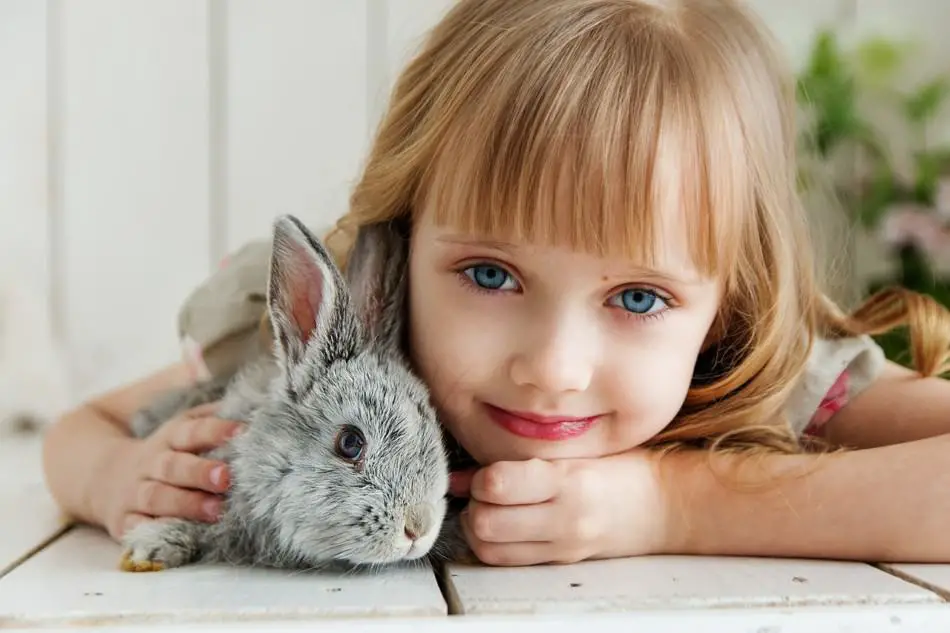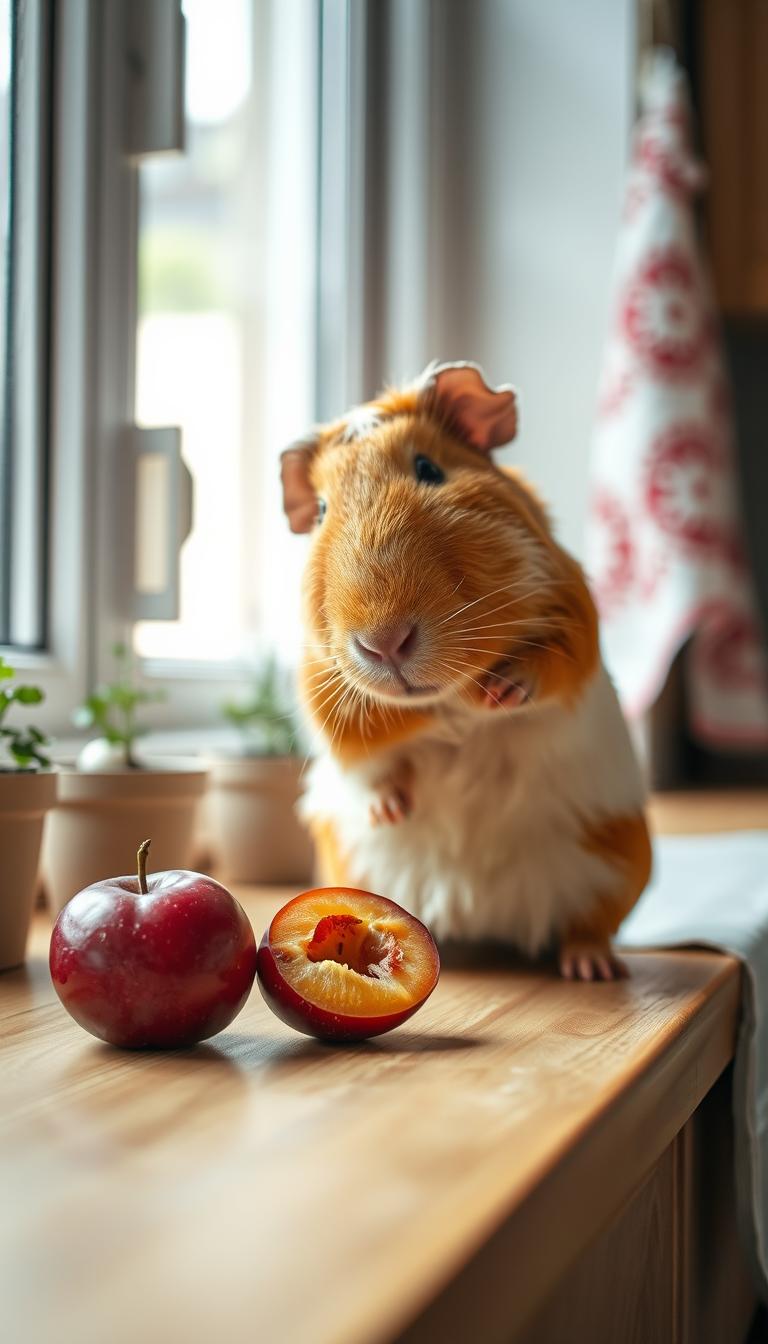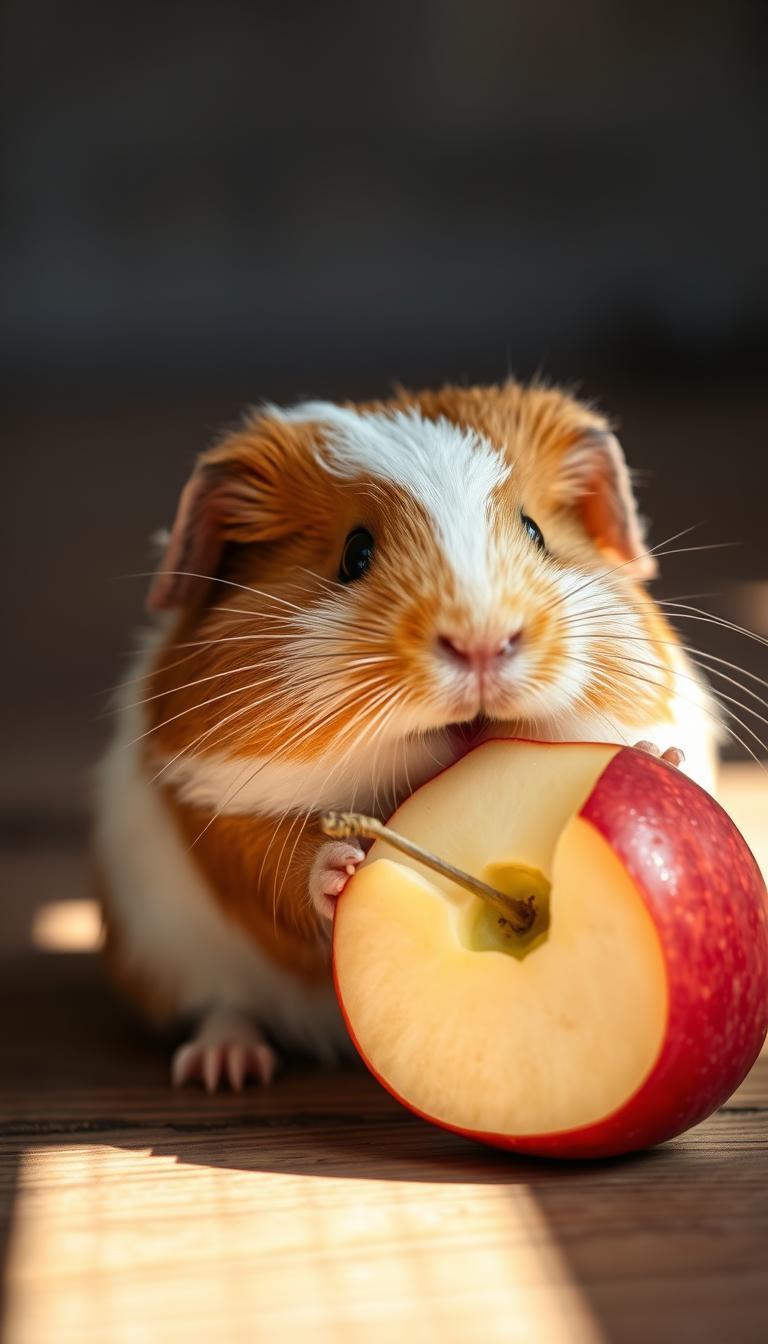Rabbits are very cute and cuddly animals but come with lots of care and responsibility. Rabbits are a big commitment to keep and are very curious animals that are always getting into trouble.
This keeping pet rabbits guide will tell you everything you need to know to care for your bunny and how to keep them healthy and happy.
Table of Contents
Diet
Keeping pet rabbits requires the owner to know and understand the needs and requirements of their pet, including their dietary needs.
Rabbits need a very diverse diet of pellets, hay, fruits and vegetables as well as treats. However, some foods are toxic to rabbits and should be avoided. We wrote about them in another blog which you can read here.
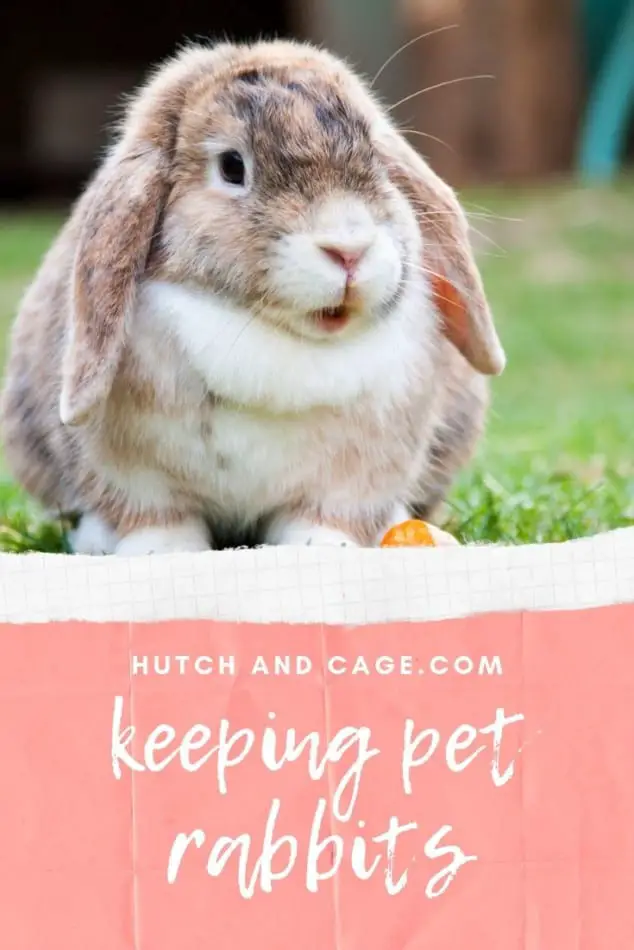
Hay
Most of a rabbit’s diet should be made up of hay. Most veterinarians recommended around 70% of their diet to consist of hay.
It is best to give them a variety of hay to choose from. If you’re keeping adult pet rabbits, do not give them alfalfa hay.
Alfalfa is very high in calcium and should only be given as a treat and to younger growing rabbits. Adult rabbits should eat timothy hay or a hay mix blend.
Pellets
Your rabbit will need a daily supply of pellets. Pellets should consist of about 20% of their diet. These are very high in fiber which is needed for digestion.
Pellets also contain the added amounts of vitamins and minerals that are not found in hay and veggies. Try to avoid the mixtures with nuts, seed, and fruits as most rabbits will eat these and avoid the healthier pellets.
We feed our rabbits Ecotriton rabbit pellets from Amazon.
Vegetables
Fresh vegetables are a great way for your pet to get vitamin and minerals. Vegetables should consist of about 8% of their diet.
They are also a good source of moisture. A good guide for feeding greens is to feed 1 cup of greens per 2 pounds of body weight. You can either feed this all at one time or divided into many feedings throughout the day.
Vegetables in the cabbage family such as kale, cabbage, bok choy, broccoli, brussels sprouts, collard greens should be fed with caution to your rabbit as they can cause some very painful gas.
Greens that have very dark leaves are usually very high in calcium. Rabbits are already at a high risk for calcium problems. It is best to rotate vegetables and give your rabbit a break from dark green leafy greens.
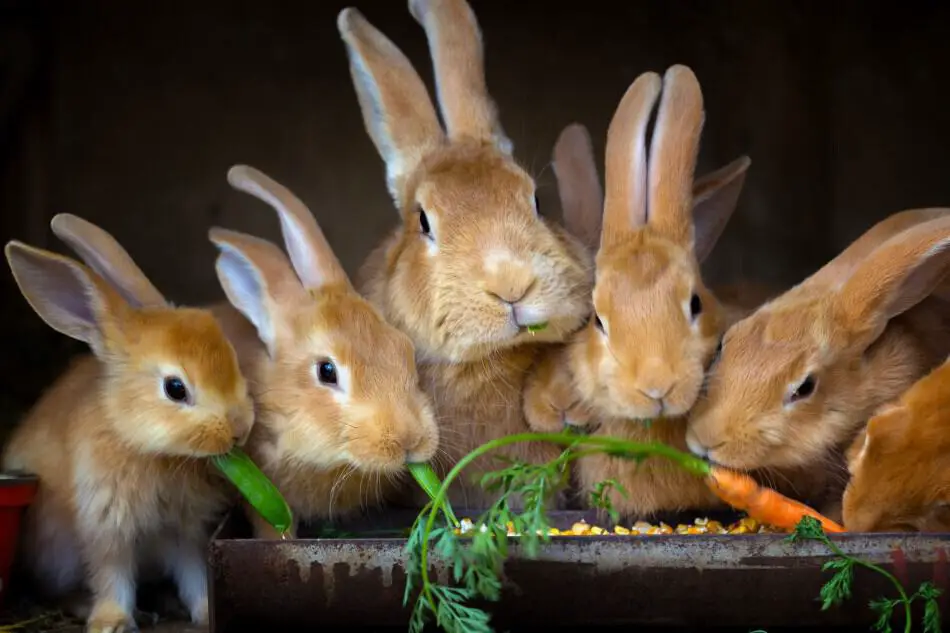
Carrots can be very high in starches and sugars.
The normal gut flora can be very sensitive in rabbits and a change in starch or sugar intake can disturb this balance causing a lot of GI problems. Carrots, fruits, and dried fruits should be limited to a 1-inch size piece a day
Good vegetables to feed your rabbit include:
- Alfalfa, radish & clover sprouts
- Basil
- Beet greens (tops)
- Bok choy
- Broccoli (mostly leaves/stems)
- Brussels sprouts
- Carrot & carrot tops
- Celery
- Cilantro
- Clover
- Collard greens
- Endive
- Escarole
- Green peppers
- Kale
- Lettuce: Romaine, Red or Green leaf
- Mint
- Mustard greens
- Parsley
- Pea pods (the flat edible kind)
- Peppermint leaves
- Raddichio
- Radish Tops
- Raspberry leaves
- Spinach
- Watercress
- Wheatgrass
The following vegetables are not recommended to feed your rabbit: Iceberg lettuce, nuts, legumes (beans), yogurt, bread, crackers, seeds, popcorn, onion, garlic, potatoes, chocolate or rhubarb.
Fruits
Most fruits are high in sugars and should only be given as a treat. Small amounts of fruits a few times a week are good for your rabbit’s diet.
Fruit should never be the main source of your pets’ diet. Start off slowly and add one fruit at a time to your rabbit’s diet.
Monitor your rabbit’s stools and make sure they do not get diarrhea from the new fruit before adding ‘a different fruit to their diets.
Good fruits to feed your rabbits:
- Apple
- Blueberries
- Mellon
- Orange (including the peal)
- Papaya
- Peach
- Pear
- Pineapple
- Plums
- Raspberries
- Strawberries
Treats
Giving treats is a great way to bond with your rabbit. Treats should only consist of about 2% of your rabbit’s diet. Offering a variety of treats just a few times a day will help you bond with your rabbit.
Make sure your rabbit is eating all of their other food before offering treats. If you only offer treats, they will just eat them all and not the pellets that contain all the needed nutrients.

Water
A rabbit’s diet must also include plenty of water. A small rabbit will drink the same amount of water as a 20-pound dog.
This may seem like a lot of water to most, but they do require a lot of water in their diets.
Your rabbit should be allowed access to fresh clean water every day. Most rabbits will drink from a water bottle or from a bowl.
If you adopt an older rabbit, give them a choice of both until you figure out which type of watering system they prefer. A rabbit’s water bottle should be cleaned with hot water every day.
Here’s the water bottle we use for most of our small pets including rabbits.
Toys
As with any animal, a rabbit will need a lot of toys to play with. Some of these can be made from everyday household items or purchased from a pet store.
What kind of toys do I need for my rabbits?
Rabbits are very curious animals and they love to chew. A rabbit’s front teeth are constantly growing and they need something to chew on to continuously file down their teeth.
Giving them access to wooden blocks or wooden toys is best.
These toys should be taken away from your rabbit when they get small enough that they could get easily stuck in their mouth.
You can also give your rabbit empty toilet paper rolls filled with hay. This is a good thing for them to chew on and also a way for them to get more access to hay.
Housing Your Bunny
Keeping pet rabbits also requires the owner to understand the different types of housing available and choose the most suitable for them.
Most bunny experts recommend housing your rabbit indoors. Many pet rabbits do not do well with the hot southern summer or the cold northern winters.
Unless you can regulate the temperature of an outdoor enclosure, keeping your rabbit inside is best.
Indoor housing
The best type of cage for indoor housing is usually one that you construct yourself. Many of the store-bought cages are fine for baby and very small pet rabbits but most rabbits will outgrow their cage.

There are many DIY cage instructions on YouTube. One of the most popular cage ideas that are used among many rabbit owners is the NIC rabbit cage design.
These cages are made using wire cube squares zip tied together. These are the cubes that are used to make the NIC cages Click here
Outdoor Housing
If you live in an area with nice weather year-round, housing a rabbit outdoors can be possible. You can purchase a rabbit hutch for your rabbit to escape to during bad weather.
Most of these hutches are off the ground and rabbit pellets will fall through the mesh on the bottom.
Make sure that your rabbit’s hutch/cage has a solid surface that they can also get on and rest their feet from standing on the wire cage all the time.
Usually, the enclosed part of a hutch has a solid floor that you can put hay in for eating and to use as bedding.
Bedding for your rabbit’s cage
The best bedding for your rabbit’s cage is something made of paper material. Care Fresh bedding is one of the most popular brands to put in your rabbit’s cage. This is the link to Amazon where you can purchase care fresh bedding.

Reviews on Amazon
here!
This bedding has no odor and will not harm your pet rabbits if they eat some of it. NEVER put cedar or wood shavings in the cage with your rabbit. These types of bedding have a very strong odor.
Your rabbit is sitting about 2 inches from this bedding and it can be an irritant to their eyes and nose.
A good rule of thumb is to stick your nose in the bedding and if you wouldn’t want to smell that scent all day, neither does your rabbit.
The bedding should be inspected daily for any soiled areas. Those areas should be removed, and new bedding added.
The cage should be totally emptied and changed every 1 to 2 weeks or sooner if you have a very messy bunny.
Litter Box Training Your Rabbits
The majority of bunnies can be very easily litter box trained. Most bunnies will use the bathroom in one corner of the cage.
Placing their litter box with some litter in the corner and most pet rabbits will readily continue going to the litter box.
Litter box training your rabbit will greatly cut down on the number of bedding changes and cleaning you will have to do.

Here On Amazon
Rabbits love to eat hay while in their litter boxes. Putting some hay on top of the litter will help them learn to use the litter box.
Also, a good way to get a rabbit to use a litter box is to hang a hay feeder over their litter box.
When they eat hay, this will stimulate their GI system to move to cause them to need to poop at the same time.
The best litter to use is some kind of paper litter or the care fresh bedding.
Most people will use yesterday’s newspaper for litter as this does a great job at absorbing the urine and decreasing the smell.
This is the link to Amazon where you can purchase the yesterday’s news bedding.
NEVER use cat litter in a bunny’s litter box. Bunnies love to eat things while in the litter box and cat litter can cause a blockage very quickly.
Bunny Proofing your home
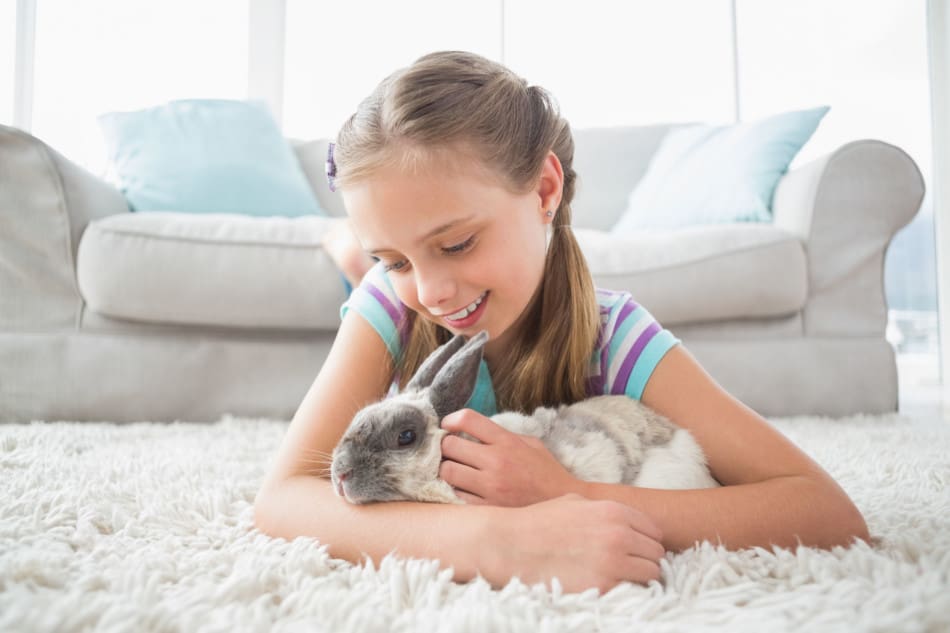
If you have a bunny in a cage, they will need some time out of their cage to run around and exercise.
They make large circular pens for rabbits to run around in but sometimes it is just easier to let them run around the room that they live in.
Pet rabbits will chew on anything and everything that they can get into their mouths.
It is a good idea to bunny proof the room that the rabbit will have free roam in.
All electrical wires from lamps and other electronic devices should be put into a cord protector. You can purchase these cord protectors on Amazon Click here!
Breeding your rabbits
Many people who own rabbits will allow them to breed. Rabbits reach sexual maturity at around 4 to 6 months of age. At this time, you may notice sexual behaviors between your pet rabbits.
The gestation period of a rabbit is around 30 days.
You will notice that a few days before the mom has babies they will start to nest by pulling hair out of their dewlap and make a nest in a corner of their cage.
Do not disrupt your rabbit’s nesting process; it is usually best to decrease the amount that you are near the cage until after she has given birth.
Once a mom has given birth, do not handle the babies for a few days. Some moms will be very territorial with you messing with her new babies.
Sexing your rabbits
Young rabbits can be very hard to tell apart. As a rabbit reaches maturity the male rabbits are very easy to distinguish.
Male rabbits have very large testicles that are long and lay right up against their body under their tail. Most veterinarians can tell males from females at young ages.
Spaying and neutering rabbits
If you do not plan on breeding your rabbits, it is best to get them spayed or neutered. This procedure should be done by a veterinarian who regularly sees exotic animals.
Not all veterinarians are comfortable with exotic animals so finding one who is can sometimes be a challenge, especially in rural areas.
Why should we spay and neuter our rabbits?
Rabbits can reproduce very quickly. The mothers only carry their young for about 1 month. Rabbits can have very large litters of 6-8 kits at a time.
Spaying your female rabbit will cut down on unwanted baby rabbits. Female rabbits are also very prone to uterine cancer. By spaying, your rabbits at a young age will eliminate this disease in your rabbits.
Male rabbits can become very territorial and sometimes very aggressive. Neutering your rabbit at a young age will not only prevent unwanted litters but also decrease aggressive behaviors.
Reasons you should see your veterinarian
There are many reasons why you should take your rabbit to the veterinarian immediately. If you notice anything wrong with your rabbit seeking veterinary care as soon as possible is best.
Rabbits are natural prey animals and do not show signs of illness until sometimes it is too late.
These are some common reasons you should seek veterinary care:
- Loose, soft, small or no stool
- Blood in urine
- Sneezing or trouble breathing
- Lack of activity
- Overgrown front teeth or difficulty chewing
- Bald spots of fur
- Sores on feet
- Eating or drinking less
Here’s a list of Vets in the USA that you may find helpful
Here’s a list of vets in the UK
Conclusion: Rabbit Care Guide
This guide is packed full of good information on how to take care of your rabbit. There is also a lot of good information on the internet on care and maintenance of your rabbit.
If you notice any problems with your rabbit take them to a veterinarian immediately. A sick rabbit can be a serious and deadly problem very quickly.
It is better to be over worried than not notice that your rabbit is sick, and it is too late to do anything about it.
A rabbit can be a very fun and loving pet for your family to enjoy for many years.

